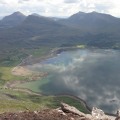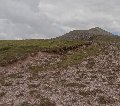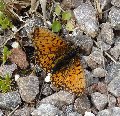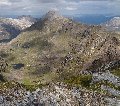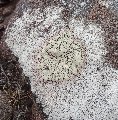|
Sgorr a Chadail and Mullach an Rathain - Daniel and Clare's
photos (13th July 2011)
Echoes of fire, water, and a rare visionary: Liathach's West end[Detailed version: there is a summary available]. |
[There's a route map on our Walk Highlands website report for this walk (at the bottom of the page).]
For us this was a special journey from an ultra-special place. Reflections came to us in many ways: directly off the water, less immediate hallmarks - of the recent fire on Liathach, and distant but still poignant reminders of some of Torridon's history:
This was our fourth summer holiday in Torridon. Back in 1999 and 2000 we'd planned to try Liathach, from the usual starting point east of Glen Cottage, but both times were defeated by the weather.
Last year (2010), we got as far as the waterfall - a lovely spot. It was the last day of our week in Corrie, and we'd had a great time, but were tired and had a long cycle ride to do the next day. Perhaps trying Liathach would have been pushing our luck: we'd been to the top of Beinn Eighe earlier in the week! But also the weather was quite dull: it was dry and the cloud was off the tops, but the light and views weren't too encouraging. The steep bit above the waterfall tried us a bit, so in a way we lacked confidence and incentive to continue. From this peaceful, airy vantage point, we watched the world go by, (and lots of vintage Jaguars on the road far below us - it had been old BMWs a couple of days before, and Lotuses on the day we arrived!), and lingered long before returning to the cottage. Seana Mheallan and the Coire a Cheud Chnoc (Corrie of a hundred hills), looked good from there.
[To see any of the photos below at a bigger size, please
left-click on the (small)
photo in the table: You can step through the photos on the
enlarged display by using
the arrow keys; press Esc to quit the bigger display.
To make the enlarged display full-screen size, press F11. The full-screen
mode will take effect once you move to another photo.
Press F11 again to get it back to normal size,
etc.
Each box on this page is linked to
a self-contained slide-show. You can start the slides at any point in
a box clicking on any thumbnail]

The waterfall a little way up the usual Liathach ascent path (2010) |

Seana Mheallan and the River Torridon, from by the waterfall (2010) |

The Coire a Cheud Chnoc, from the same spot (2010) |
This year, would it be fourth time lucky? We'd already decided not to go near the Am Fasarinen pinnacles, or the bypass path, which by all accounts is very exposed as well. But we weren't too sure how we'd manage getting to the Spidean and back - or if it would be just too near our limit for us to enjoy it.
The west end of the ridge, Sgorr a Chadail, did however take our fancy: It's a prominent feature from Corrie, particularly from Lochside Cottage, where we were staying: The shoreside views this year and last, and study of maps, suggested that it could give a spectacular bird's eye view of Loch Torridon.
Viewed from where most people see it from first, either across the loch on the south side, or from Torridon (Fasag) village, it has a rounded profile, but this becomes more distinctive as you get closer underneath it to the west:
We had wondered for a while about climbing Mullach an Rathain from round the back, up Coire Mhic Nobuill. Later, Peter Barton's book "Walking in Torridon" (Cicerone) confirmed this: he's the only author so far we've seen suggest this route.
So we set off on foot from Lochside on a perfect summer morning. For some reason which we can't remember, we decided to go east along the shore and up the twisty road to the Coire Mhic Nobuill car park. Going west through the woods, then up the path along the Allt Mhic Nobuill, i.e. staying on the Torridon House Estate to get to the car park, would have been very much quicker. But it was worth doing, as the shore road eastwards is right by the loch, and the views from the road are open and very promising.
The Corrie fish trap is clearly visible in the last photograph of this next group. Murdoch MacDonald's book, "Walking into the Past - Historical Walks in Torridon" is a wonderfully evocative yet unsentimental piece of writing, which takes you into various hidden corners of the area. One of his walks is to some shielings further up Coire Mhic Nobuill. On the way, he explains that McCuish, who lived under an overhang further up Coire Mhic Nobuill, built the trap, and visited it daily for food. There's a rather better-known fish trap at Am Ploc, Fasag, at the head of Loch Torridon: we'll get a bird's-eye view of this later on. These are tidal fish walls - shallow "dry" stone dykes across a small bay: they are submerged at high tide, so the fish can swim over them into the bay. As the tide recedes, they can't swim out. They haven't been used probably for a century or so.
Soon we were at the bridge of the Allt Mhic Nobuill - well, not that soon, as it was hot and sunny, conducive to leisurely walking. And we're always very slow for the first part of a walk. The falls upstream from the bridge are a little shy, but always worth a look. We stopped on a familiar flat rock near the start of the path up the Coire Mhic Nobuill, enjoying the dappled sunlight, before continuing on up the Coire. The much-photographed waterfall was bright, and Beinn Alligin impressive as ever.

The waterfall upstream from the Corrie road bridge |


Woodland at the start of the Coire Mhic Nobuill path |

The waterfall above the Coire Mhic Nobuill woods |
Just beyond where the Allt a'Bhealaich joins the Allt Coire Mhic Nobuill (NG882589), the main path crosses by a substantial footbridge At this point, instead of crosssing the bridge, we headed directly up the hill towards the ridge just east of the Sgorr (at a bearing of 110-120 degrees). Peter Barton does "admit that it's a slog", and it was, being steep yet marshy. This slope faces north, but the ground was still surprisingly wet given how dry a year it had been: the fire-scars on the south side were soon to give us a strong reminder of that. There's no path, so we picked the best lines we could, using the ends of ledges and trying to avoid the many places where the ground had been churned by deer. We saw a stag splendidly silhouetted on the skyline.
The views opened out, dominated by Beinn Alligin, but it was also interesting to see over the complex hidden world of gneiss hills and lochs above Wester Alligin: here a different though shallower angle than from Beinn Alligin or An Meallan Ruadh, which we'd ascended on previous visits. To the right (east) of Alligin, Beinn Dearg was also prominent, the two framing Baosbheinn behind the Suiligean Bealach, the "eyes" of the Bealach, as this cluster of lochs just in front of Baosbheinn are known. This is another prominent spot in Torridon history, with Carn Doineag nearby. "Walking into the past" also tells this story, as does Brenda Macrow's book on Torridon. ("Torridon Highlands", Robert Hale Ltd., 1953)
It was good to see the long rocky island of South Rona - little did we know that we'd be on South Rona the following day! (We hope to write this up soon!). We went with Torridon Seatours, on the Seaflower, and had a fantastic time with them, and on the island. But back to the Sgorr...
After what turned out to be the toughest part of the day - 1700 ft or so of vertiginous bog - quite suddenly the angle became much easier. We stopped for a break here, and then it was an easy walk to the ridge, and a short stroll to the Sgorr. The views ahead expanded quite suddenly.
From the shore we had seen patches of burnt trees a fair way up the hill, westwards along much of Liathach. It wasn't clear from below, but once on the ridge you could see that April's fires had reached all the way to the top of the south face of the Sgorr. Fire obviously spreads easily up very steep slopes, which the southern face of the Sgorr is, although it was perhaps surprising that it had been so dry so high up, so early in the season.
Large areas round the cliffs of the Sgorr were still bare, over two months on and well into the summer: this is seen in these photos looking east to the Mullach from the top of the Sgorr, and on the south face of the Sgorr.
The damage stopped quite abruptly on the ridge, which is quite narrow at the Sgorr end. There were patches of burnt ground on the short turf, and some places amongst the rock where the lichen the ground cover didn't look quite right:
This rather sombre reminder of fire's indiscriminate power hit us at the same time as some glorious views:
We sat for a good long while looking across the loch at these views. Those to either side also had us captivated:
The views to the north, to Beinn Alligin and the Flowerdale forest were also great but still better further on... We relaxed for a good while on the Sgorr, could happily have stayed on this airy spot all day, almost directly above the cottage where we started - probably further above it than away from it!
But time was on our side and we fancied the Mullach - after all, most of the climbing was done by this point. We found Peter Barton's description of the walk to the Mullach very pertinent: From the Sgorr, it was mainly easy, both the gradient and the terrain: a lot of the rockier parts were flat and good to walk on. At one point there were sandbanks, rather unexpectedly, but also plenty of sub-arctic terrain typical of many plateaux in the highlands: quite reminiscent of some of the Cairngorm plateaux (not the highest ones, however).
Before we progress up the Mullach, the first photo of the next group is a quick glimpse from the Sgorr, over the lower east end of Beinn A'Cheircaill (A Choineach Beag, or Choinneachadh Beag, as it's spelt on the Barts half-inch map of 1972), across to the jagged peaks of the Fisherfield Forest. After that, we're looking ahead and up!
Near the Mullach it got stonier and looser, until the false summit at the tor which is a prominent feature of Liathach when viewed from the south and west. There are some good "pancake" rocks here. From there it's only a couple of hundred yards, and maybe a hundred foot or so, to the summit. The rock changes quite abruptly to bright quartzite, and the ridge narrows dramatically to the summit. It's perfectly safe but the sense of exposure heightened strongly: it's grassy and steep on the right (this is what Peter Barton warns about), and fearsomely rocky and precipitous on the left. The summit itself looked and felt verily perched - very exciting and a bit scary for us at least..
The Northern pinnacles, a shattered knife-edge of rock, swung away immediately to the north, and the rounder but steeper spur of Creag Dubh nan Fuaran dropped down to the south. The usual route off Liathach, on very steep scree, goes just to the east of this spur.
It felt like a crossing - almost as in a Cathedral, but so high and airy: indeed, we were referring to the east and west ends of Liathach. Richard Gilbert, in his book on the Northwest Highlands ("Exploring the far north west of Scotland" - Cordee Press, 1994) says that when looking at Liathach he is reminded of Ruskin's words:
"These great cathedrals of the earth,
with their gates of rock, pavements
of cloud, choirs of stream and stone,
altars of snow, and vaults of purple
traversed by the continual stars."
No snow today - perhaps one day we might see that. But much else in abundance... These awesome spurs from the Mullach are something like transepts, perhaps? But not even the most staggeringly beautiful medieval tracery of any of our churches can compare with the feeling of being on this peak.
A red admiral joined us right at the summit - quite a surprise: we've seen them occasionally on high summits before, but hadn't seen any for a couple of years. Nor many other butterflies on this holiday up to that point, but on other days down by the shore road near Lochside Cottage we had seen some lovely blue ones also some of these large emeralds (moths) at Annat and near Glen Cottage. Also a fritillary near Slattadale the previous week. So here is a quick Torridon lepidoptera diversion...:
Here are some of the views from the top. Firstly along the spine of Liathach:
To the south:
It was a particular delight to see again Lochan Neimhe. We got closer views from high above it on the ascent of Beinn Liath Mhor a couple of days earlier. (We're hoping to write up that walk soon). One of Murdoch MacDonald's shielings walks follows the Abhainn Traill from its confluence with the River Torridon (near the village), to the lochan, its source. There are shielings on the way, clearly visible, at least they were when we went twelve years ago (1999!). We must one day take up his suggestion of circumnavigating the lochan. We instead continued along the south side of the lochan, and joined up with the Ling Hut, down through the Coire a Cheud Chnoc (Corrie of a hundred hills), then roadwalked back to Loch Torridon.
It seems that very few people visit Lochan Neimhe - it's remote and beautiful, and very atmospheric: the more so when you've read Murdoch MacDonald's writing about it. I've never seen it referred to anywhere else, although if you're into fishing and know the area well, you might have been there. We might write up that walk some day, as well, although in those days we didn't have a digital camera and only have a few prints.
Here are some views to the north. The ridge descending on the left foreground of this first photo is another north-running spur from near the summit, which with the Northern Pinnacles encloses Glas-Toll a'Bothain. To it's west is yet another corrie! This "Cathedral" has many sidechapels and, who knows, even perhaps a crypt or two? The Uamh nan Oir, low on the south side of Liathach, is after all reputed to go through to Gairloch!
Incidentally, Angela Nicholson, in her book "The Complete Traveller's Guide to Gairloch and Torridon" (Thistle Press, 1993), recounts a very similar legend about a cave near Port Erradale, well north of Gairloch, but doesn't mention the Liathach "Cave of Gold" story which is told by Murdoch MacDonald and Brenda Macrow, among others. This cave is on the south side of the hill, near Fasag village.
The distant views were also extensive. Here are some examples:
Eventually it was time to return. First, we had to decide the route. The usual path off to the south looked clear and dry, but very steep and loose. We'd also have a bit of road-walking to do at the end - less than 3 miles, and delightful road, but it looked a bit daunting. We decided we could find a better descent route on the north side of the ridge (south side of Coire Mhic Nobuill), than our upward route. So we headed back down to the shallow saddle between the Sgorr and the Mullach, aiming to come off the ridge a bit further east than where we arrived on it.
There was plenty more of interest as we descended to the saddle:
This last photo also shows the view down. Of course, ledges are hidden from above, but we found that they were generally quite short and one could easily get round their shallow ends and on downwards. This was easier than the route up, and we were facing down into a rather interesting broad corrie.
Near the bottom of the valley, we came across an odd landslip, with some quite oily-looking water at the bottom of it. This could just have been stagnant, peaty deposits, but didn't quite look like that.
We arrived at the Allt Coire Mhic Nobuill about a mile upstream from the bridge. Although it was classic boggy flats, it wasn't bad going, and in places we could pick up the old path on the south side of the Allt. Sunset was approaching fast and the air was still, so we kept a good pace up till we reached the bridge. Bridges are often good places for breeze, and we did get a bit on this one, so had our final break before descending into the woods in dusk.

The oily (?) landslip |
Once we got to the road, we decided against the road route back to Lochside Cottage. So we carried on down the Allt. There's a gate at the southeast corner of the little car park at Coire Mhic Nobuill. You may well know this car park - it's where probably most people start and finish a walk on Beinn Alligin. It's on the edge of the Torridon House estate, where we were staying. There's history here. A reasonably decent path goes on from there to join the main track through the Torridon House estate. This track runs from Rechullin, east of Inveralligin, past Coire Church (another lovely spot), and joins the shore road.
Fading light and not-fading midges mitigated against photos, but here are some of the same route from a year ago. It would be tempting to put in a good few photos from the Rechullin track as well; we've wandered this track many times, and can quite understand why Peter Barton rates the walk along it and the Alligin road as the best in the whole of Torridon!
But perhaps that's for another writeup. For now, though, we'll just include a short diversion to the Darroch memorial and the church. The photos are from a previous evening visit. This is a poignant place, in a lovely setting. Duncan Darroch was the laird of Torridon from 1872 until his death in 1910. He made huge improvements to the lot of the crofters on the then very large Torridon estate, following the callous clearances and other depradations of several previous landlords. An interesting character, with a rare visionary and benevolent outlook: a laird like no other in the history of Torridon. Murdoch MacDonald's books "Old Torridon", and "Walking into the Past", give more background about him. Like "Walking into the Past", "Old Torridon" is also a wonderfully diverse and deeply written book.
Darroch did actually clear the area round Corrie so that Torridon House could be built, but, as far as we can make out, he restored so much land to the crofters, and improved their lives so much, that no-one minded - one can imagine it was just part of his overall plan, the centre of which was these crofters' considerations.
Back on our route, though. Once we joined the main track, it was on through delightful woodland, which ends just before the cottage. En route we passed Gardener's Cottage, where we'd had such a great holiday the previous year. (This group of photos were taken on different days from our Mullach walk).
We could include many photos of the different light we've seen from Lochside and the shore road, looking across Loch Torridon. Very tempting, but it's time to wind up this report, and stick to what we saw on this amazing day on the Mullach.
As we came out of the woods, so close the cottage, beyond the Loch, the moon rose over Beinn Damph, just as it had done two nights earlier when we returned from Beinn Liath Mhor. It had been a great day.
We can't praise this route on Liathach too much. If you're not actually staying in Torridon, you'll likely be starting the walk from the road bridge over the Allt Coire Mhic Nobuill. By walking from the Cottage, we added the round from there, down the Allt, east to Lochside and along the estate shore road to its junction with the Torridon-Alligin road, then back up the road. This is a great round if you have time, and the diversion to Corrie church is a mini-pilgrimage to another bit of history and memory. The church itself isn't generally open, but the memorial is on open ground with views all round.
We do hope you've enjoyed this page. It's longer than normal! Perhaps that reflects our sense of atmosphere, having stayed here and got to know it, having lingered long and absorbed so much. Walking directly from this place, without having to cycle, bus, or train out to get to the hill, made this walk extra special for us. The Highlands at their best, really. Having been much blessed, we wish you also great days on the hills and by the lochs.


Moonrise between Beinn Damph and Beinn na h'Eaglaise, at the end of our walk on Mullach an Rathain |


Clare and Daniel on the summit |
(Text and photos by Daniel and Clare Gordon. September 2011).
Please e-mail any requests or comments about this site to us at our home address, if you have it. Otherwise please use Daniel's university address, D.R.H.Gordon@leeds.ac.uk. Thank you.
This web site is written and maintained by Daniel Gordon, and hosted by United Hosting. [© D./C.G. 2024]
























